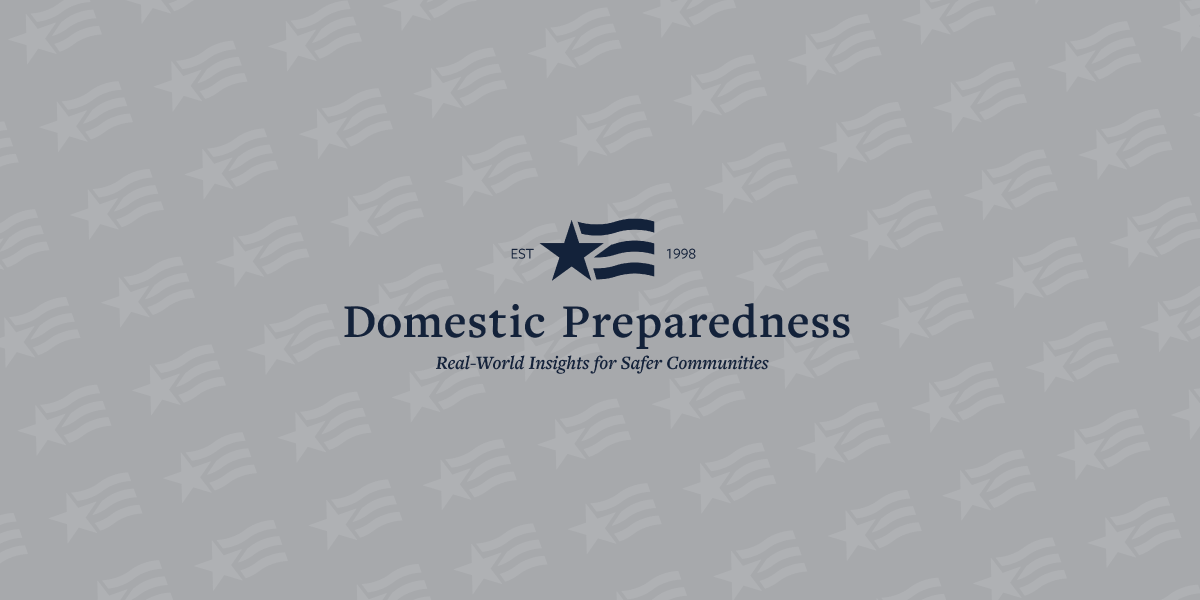Most recently published

The PPO & Surge Capacity: A Different Type of ‘Insurance’
John J. Burke
July 22, 2009
The reverberations from last month’s Washington, D.C., Metro crash were heard throughout the country – and set off a silent “”security alarm”” of sorts in the Town of Sandwich, Massachusetts, where emergency planners had their own good reasons for paying special attention.

Special Events: Reality TV for Training & Exercises
Joseph Cahill
July 22, 2009
People, weather disasters, terrorist attacks, and other criminal activities are inherently unpredictable. Which does not mean that law-enforcement and healthcare agencies cannot prepare for them by using the “special events” calendar as a training curriculum.

Security Planning for Major Events
Joseph Watson and Joseph W. Trindal
July 22, 2009
The template is there, in the Secret Service after-action reports on previous NSSEs. So are the Guidelines, issued by the Department of Justice. All that state and local emergency managers have to do, therefore, is read, heed, practice – and maybe pray a little.

Discovery Channel TV Series: The Colony – Week One
Adam Montella
July 22, 2009
No one knew exactly what happened, or how much damage their world had suffered. But they all knew that life would never again be the same. They were few in number, but they had somehow survived. By joining together they might continue to survive. But how, and for how long?

Providing Systems Engineering Support to State & Local Jurisdictions
Dennis R. Schrader
July 15, 2009
The federal government has told the nation’s states and cities to build up their homeland-security capabilities – a difficult and costly task at any time, but even more so during a recession. Here is one way to solve the “unfunded mandates” dilemma.

Premiere Performances: NSSEs, Non-NSSEs – And the Security Risks Involved
Neil C. Livingstone
July 15, 2009
The most perfectly planned and carefully implemented security plan can easily go awry. All it takes is one suicidal terrorist or deranged assassin to make a major special event much more exciting, and dangerous – for participants and spectators alike – than originally anticipated.

Emergency Management & Special Events: Challenges, Support, Best Practices
Kay C. Goss
July 15, 2009
There are few if any challenges so daunting to emergency managers than the planning and implementation of the security measures needed to protect the principals and attendees at NSSEs and other highly publicized events. The greatest success occurs when nothing happens.

London 2012: Protecting the Olympic Games
Andy Oppenheimer
July 8, 2009
The greatest challenge facing UK and London officials will not be the staging of a worthy successor to China’s sterling 2008 Games, but maintaining tight security in an open society where the cuisine may be less varied but freedom and diversity are much more highly valued.

Vigilant Guard 2009
Domestic Preparedness
July 7, 2009
Iowa, Kansas and Puerto Rico held annual Vigilant Guard training exercises.

A Global Sensor Network for Disaster Warnings
Diana Hopkins
July 6, 2009
It would be much more complicated than “a two-step smoke-alarm process,” but the nations of the world now have the technology needed to develop and build a truly global international, and interoperable, sensor system capable of almost instantaneous detection of imminent disasters. So why don’t they?

Kids Encouraged to Participate in Disaster Preparedness
C. Todd Lopez
July 1, 2009
Ensuring families are prepared for emergencies is one of the roles of the Army Protection Division, & it does so through the Ready Army program. This year, the Ready Army program is sponsoring a new program, “”Prepared Kids,”” the aim of which is to get younger family members involved in

Mid-Atlantic Officials Cite Progress, Continuing Challenges
Daniel Brethauer
July 1, 2009
Recent AHC (All-Hazards Consortium) meeting in Wilmington (Del.) serves as a working model for all states and regions seeking to institute and/or improve cooperative multi-state programs, funding efforts, and mutual-assistance agreements.

Wisconsin Air Guard Hosts Full-Scale Joint Exercise
Alyson Berzinski and Eric Liesse
July 27, 2009
The Army and Air National Guard’s annual international Operation Global Patriot exercise, hosting roughly 3,000 National Guard Troops from forty-five different states and six different coalition nations. The exercise’s overall training goal is for different coalition nations and National Guard units to work together in real-world scenarios.

The PPO & Surge Capacity: A Different Type of ‘Insurance’
John J. Burke
July 22, 2009
The reverberations from last month’s Washington, D.C., Metro crash were heard throughout the country – and set off a silent “”security alarm”” of sorts in the Town of Sandwich, Massachusetts, where emergency planners had their own good reasons for paying special attention.

Special Events: Reality TV for Training & Exercises
Joseph Cahill
July 22, 2009
People, weather disasters, terrorist attacks, and other criminal activities are inherently unpredictable. Which does not mean that law-enforcement and healthcare agencies cannot prepare for them by using the “special events” calendar as a training curriculum.

Security Planning for Major Events
Joseph Watson and Joseph W. Trindal
July 22, 2009
The template is there, in the Secret Service after-action reports on previous NSSEs. So are the Guidelines, issued by the Department of Justice. All that state and local emergency managers have to do, therefore, is read, heed, practice – and maybe pray a little.

Discovery Channel TV Series: The Colony – Week One
Adam Montella
July 22, 2009
No one knew exactly what happened, or how much damage their world had suffered. But they all knew that life would never again be the same. They were few in number, but they had somehow survived. By joining together they might continue to survive. But how, and for how long?

Providing Systems Engineering Support to State & Local Jurisdictions
Dennis R. Schrader
July 15, 2009
The federal government has told the nation’s states and cities to build up their homeland-security capabilities – a difficult and costly task at any time, but even more so during a recession. Here is one way to solve the “unfunded mandates” dilemma.

Premiere Performances: NSSEs, Non-NSSEs – And the Security Risks Involved
Neil C. Livingstone
July 15, 2009
The most perfectly planned and carefully implemented security plan can easily go awry. All it takes is one suicidal terrorist or deranged assassin to make a major special event much more exciting, and dangerous – for participants and spectators alike – than originally anticipated.

Emergency Management & Special Events: Challenges, Support, Best Practices
Kay C. Goss
July 15, 2009
There are few if any challenges so daunting to emergency managers than the planning and implementation of the security measures needed to protect the principals and attendees at NSSEs and other highly publicized events. The greatest success occurs when nothing happens.

London 2012: Protecting the Olympic Games
Andy Oppenheimer
July 8, 2009
The greatest challenge facing UK and London officials will not be the staging of a worthy successor to China’s sterling 2008 Games, but maintaining tight security in an open society where the cuisine may be less varied but freedom and diversity are much more highly valued.

Vigilant Guard 2009
Domestic Preparedness
July 7, 2009
Iowa, Kansas and Puerto Rico held annual Vigilant Guard training exercises.

A Global Sensor Network for Disaster Warnings
Diana Hopkins
July 6, 2009
It would be much more complicated than “a two-step smoke-alarm process,” but the nations of the world now have the technology needed to develop and build a truly global international, and interoperable, sensor system capable of almost instantaneous detection of imminent disasters. So why don’t they?

Kids Encouraged to Participate in Disaster Preparedness
C. Todd Lopez
July 1, 2009
Ensuring families are prepared for emergencies is one of the roles of the Army Protection Division, & it does so through the Ready Army program. This year, the Ready Army program is sponsoring a new program, “”Prepared Kids,”” the aim of which is to get younger family members involved in
Wisconsin (The Adjutant General) TAG Holds e-town Hall
Wisconsin National Guard
June 27, 2009
The online town hall session is one of the methods the Wisconsin National Guard is using to communicate with internal and external audiences.
Trauma & Burn Centers – Coping with MCI Disasters
Theodore Tully
June 24, 2009
Numerous mass-casualty incidents have demonstrated the value of building and staffing a number of medical centers dealing primarily with trauma and burn patients. But even those centers may not be able to care for all victims of a “mega-disaster” such as the 9/11 terrorist attacks.
The Now Possible Dream: Communications Interoperability
Kay C. Goss
June 24, 2009
Firefighters, policemen, EMS technicians, & other first responders agree that one of their biggest on-the-job difficulties has been their inability to communicate with their counterparts from other jurisdictions. That huge capabilities “”gap”” may soon be closed, thanks to improved technology and better planning.
ServNC Shapes Quick Response to Icy Kentucky
Ann Marie Brown and Jeffrey B. Peterson
June 17, 2009
Thanks to EMAC, ESF-8, and other mutual-assistance policies and programs, individual states no longer have to go it alone when facing a hurricane, an earthquake, a terrorist attack, and/or other disasters, natural or manmade.
NLE-09: A Major Test for the Obama Administration
Dennis R. Schrader
June 17, 2009
The former TOPOFF domestic-preparedness exercises designed to test the capabilities and fortitude of the U.S. defense/DHS hierarchy have evolved into a new format – which the nation’s new commander in chief will meet face to face next month.
When Disaster Strikes: Duty First – Then Remembrance and Reflection
Joseph Cahill
June 10, 2009
The children and grandchildren of the Greatest Generation that won World War II are worthy successors, serving their nation as firefighters, policemen, EMS technicians, and hazmat specialists. Many of them also demonstrate, with their own lives, the last full measure of devotion.
EMS and Suicide Bombings – Some Potentially Deadly Considerations
Raphael M. Barishansky
June 10, 2009
Most terrorist attacks against the United States have been large-scale incidents. But the demonstrated willingness of individual martyr-terrorists to serve as suicide bombers has changed the equation and requires much greater attention than it has been given so far.
NIMS: Not a Once and Done Proposition
Stephen Grainer
June 3, 2009
The “”revolutionary era”” of U.S. homeland security started with the terrorist attacks of 11 September 2001. A new era, focused on the maintenance and upgrading of hard-earned responder skills, is about to begin.
Ice Storm 2009: Kentucky’s Regional Response
Margaret Riggs
June 3, 2009
First-person report: How Kentucky coped with “frozen Hell” earlier this year by making full use of not only its own responder capabilities but also those available through CDC’s Career Epidemiology Field Officer program.
Preparing for the Worst in Cyber Security
Amit Yoran
May 27, 2009
The high-tech professionals entrusted to protect and preserve a company’s – or country’s – IT networks do not always recognize that their first operational priority should be the protection of their own equipment, specifically including detection and encryption systems and devices.
Mass Prophylaxis: The Brass Ring of Public Health Preparedness
Bruce Clements
May 27, 2009
It sounds like a mission impossible, but U.S. public health officials are determined to find a way to provide pandemic medications, within 48 hours, to everyone within a major metropolitan area endangered by pandemic influenza or a potentially lethal bioterrorism attack.
Questions of Preparedness: A Spring of Tragedy for Law Enforcement
Joseph W. Trindal
May 27, 2009
The murder of a police officer is both a community and personal tragedy. Better equipment and improved training are helping to improve survivability, but society’s criminal element has access to the same equipment and the result has been an increase in law-enforcement fatalities.
Follow Us
Get Instant Access
Subscribe today to Domestic Preparedness and get real-world insights for safer communities.


